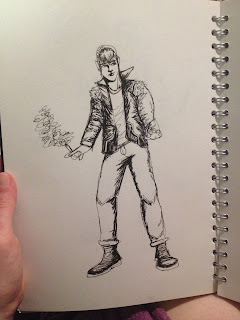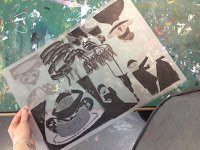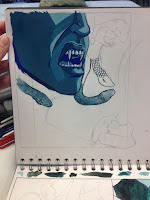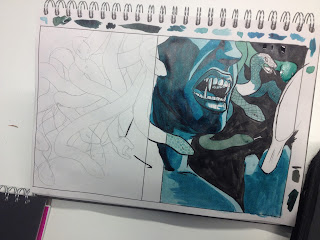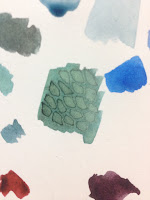Thursday, 26 November 2015
Mark-making
Screenprinting the hotdog book!
We printed the book today - here's the outcome:
What went well:
What didn't work:
What we could have done differently/could do next time:
 |
| Front - Hayley |
 |
| page 1 and 2 - Chris/Isaac |
 |
| page 3 and 4 - Kieran |
 |
| page 5 and 6 - me |
 |
| Back - Hayley |
What went well:
- Colours worked well together
- Works well as a narrative
- Teamwork!!
What didn't work:
- I personally don't think the title stands out very well - the font Hayley chose was hard to read, especially when the different colours didn't line up perfectly.
- The template print when we did the second colour printed when the plastic sheet was kinda folded weird, so when we lay it straight it meant it didnt actually line up like we thought it would.
- I forgot to draw some detailed lines on the red sheet, meaning they were lost when we printed over the yellow.
- We all thought the yellow and red crossover would make a more obvious orange, but that also caused us to lose some detail - the red was a bit too dark. It looked better on some versions where the red wasn't as boldly printed.
What we could have done differently/could do next time:
- Make sure everything is on register and lined up.
- Draw the image darker on the plastic first - had to spend some time going over everything to make sure it was dark enough to expose well.
Overall a fun experience though!! Will definitely be trying it again
Tuesday, 24 November 2015
Hotdog book ideas development
Today in our group we went about coming up with ideas for our hotdog book. We all picked similar moments from the day to explore further - the pigeons, the beautiful statue and 'mustard titty' were the three moments that came up more than once. I drew out some roughs to see how they worked as narratives.
 The statue moment I had a bit of trouble with making it interesting so I moved on from that idea, and I really liked exploring the North Bar adventures, but no-one else in the group really like that one, so I scrapped it. A few of the others really liked the pigeon idea, but it seemed a lot of people were doing pigeons so we opted for the 'mustard titty' in the end.
The statue moment I had a bit of trouble with making it interesting so I moved on from that idea, and I really liked exploring the North Bar adventures, but no-one else in the group really like that one, so I scrapped it. A few of the others really liked the pigeon idea, but it seemed a lot of people were doing pigeons so we opted for the 'mustard titty' in the end.
We all drew our own mock-ups and then picked recurring panels across all our mock-ups for the final one and divvied up who would be drawing what. That was a bit weird because in a group project you've got to be fair, even if you feel like you want to draw everything your own way! I picked my two panels but I kinda wanted to do the front too, just because I really like playing around with typography and thought my idea worked well. However, Hayley got the cover and she decided to incorporate the title into smoke coming from the grill. I was bit disappointed but everyone liked that idea better it seemed so we stuck with that.
We decided on red and mustard yellow because ketchup and mustard.





 The statue moment I had a bit of trouble with making it interesting so I moved on from that idea, and I really liked exploring the North Bar adventures, but no-one else in the group really like that one, so I scrapped it. A few of the others really liked the pigeon idea, but it seemed a lot of people were doing pigeons so we opted for the 'mustard titty' in the end.
The statue moment I had a bit of trouble with making it interesting so I moved on from that idea, and I really liked exploring the North Bar adventures, but no-one else in the group really like that one, so I scrapped it. A few of the others really liked the pigeon idea, but it seemed a lot of people were doing pigeons so we opted for the 'mustard titty' in the end.We all drew our own mock-ups and then picked recurring panels across all our mock-ups for the final one and divvied up who would be drawing what. That was a bit weird because in a group project you've got to be fair, even if you feel like you want to draw everything your own way! I picked my two panels but I kinda wanted to do the front too, just because I really like playing around with typography and thought my idea worked well. However, Hayley got the cover and she decided to incorporate the title into smoke coming from the grill. I was bit disappointed but everyone liked that idea better it seemed so we stuck with that.
We decided on red and mustard yellow because ketchup and mustard.





Monday, 23 November 2015
Visual Narratives One Week Book project research
First brief of the Visual Narratives module - making a screenprinted hotdog book in a group. We were sent around Leeds for adventures n ting, so here's what we got up to (with exciting pix):
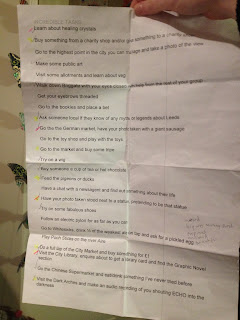 The list we were given, with everything we did checked off. The following pictures are my favourite moments.
The list we were given, with everything we did checked off. The following pictures are my favourite moments.
Charity shop shopping next - Kieran trying on 'fabulous' shoes, and I bought a 'pin the moustache on the cowboy' game, but stuck the moustaches on various displays around Leeds. I will continue to use them well for the moustache TV drinking game.
Hayley bought some cute salt and pepper shakers and captured them with two accordionists - one was super happy and cute, and the other was a grumpy sod.
Anyway, we got loads of cool stories to possibly tell - my favourties are probably the Big Ass Money Stout, or just everything that happened in North Bar in general, or the mustard titty story. The others like the pigeon idea too, which could also be interesting to do. Time to get onto roughing.
 The list we were given, with everything we did checked off. The following pictures are my favourite moments.
The list we were given, with everything we did checked off. The following pictures are my favourite moments.
We bought German sausages at the Christmas market and were highly amused by the 'mustard titties'.
Chris posing in front of a statue, and the couple below walked past and commented, 'He's very beautiful!', so I took their picture (with permission!). We also stole a sandwich from Starbucks to feed the pigeons with. I say stole, but it had been left half eaten, and even though the hot chocolate in the cup was still warm, we waited for 10 minutes to see if anyone would claim it but they didn't. So we did. The pigeons enjoyed it.
Charity shop shopping next - Kieran trying on 'fabulous' shoes, and I bought a 'pin the moustache on the cowboy' game, but stuck the moustaches on various displays around Leeds. I will continue to use them well for the moustache TV drinking game.
Hayley bought some cute salt and pepper shakers and captured them with two accordionists - one was super happy and cute, and the other was a grumpy sod.
We bought 5 toy cars at the market for £1 and took some pictures near the dark arches, and then visited North bar, where they had an awesome wall of beer flagons (is that right?) with the regulars' names on them. I thought that was a cool local legend.
The Australian bartender, Cara, also let us try some samples of beer and told us about a Norwegian brewery that decided to brew the most alcoholic beer they could - 17.6%!! They called it Big Ass Money Stout (hahaha) and apparently brewed it with real money, then took the money out and dried it, bought some frozen pizza, and then put that in the vat too!! Unsurprisingly, it was apparently gross (unfortunately that was a few months ago and it was a limited time only). Kieran tried blue cheese for the first time and I managed to capture the exact moment he realised it was a big mistake. Hayley and I also tried on wigs! Considering cutting my hair into a bob and dying it silver now!
Anyway, we got loads of cool stories to possibly tell - my favourties are probably the Big Ass Money Stout, or just everything that happened in North Bar in general, or the mustard titty story. The others like the pigeon idea too, which could also be interesting to do. Time to get onto roughing.
Monday, 16 November 2015
OUIL403 Visual Skills Final Self Evaluation
1.
Which practical skills and methodologies have you developed within
this module and how effectively do you think you are employing them within
your own practice?
|
|||||
·
Experimenting
with different media - particularly Photoshop, expanding from the Visual
Language workshops, seeing how images work in different formats. Going back
to using paint again instead of focusing on inks - sometimes ink isn't the
best fit and it helps to experiment.
·
Roughs/ideas
generation - previously I've been used to generating ideas in my head and
writing them up as lists or brainstorms rather than presenting them visually,
but having to do roughs helped me realise getting ideas down visually is a
big help, particularly in Brief 1 where I realised I couldn't actually
illustrate (well) some ideas for each of the 10 themes.
·
Blogging -
having to write down that mental conversation with myself helped me realise
further things about my own practice by getting down the jumbled thoughts in
my head into a clear presentable format.
·
Loosening up
my drawing by working to a small timeframe - similar to roughing, not being
so precious about my drawing, as it's more important to get ideas down rather
than being concerned with having perfect illustrations in the early stages.
|
|||||
2. Which principles/ theories of image
making have you found most valuable during this module and how effectively do
you think you are employing these within your own practice?
|
|||||
·
Limitations
on colour and size/format across all the briefs helped me to realise that
sometimes the more simple illustration is better for that particular brief,
and it helps to make the mistake of drawing something too complex and
simplifying it. I even decided to stick to a limited colour palette for the
third brief even though there were no formal restrictions because of this.
·
Looking at
other artists' work, relating to PPP and my new Pinterest account - helps to
see how other artists create their work and apply the knowledge of
professional practitioners to my own practice.
|
|||||
3. What strengths can you identify within
your submission and how have you capitalised on these?
|
|||||
·
Authorship -
my personality and interests definitely show across each of the 3 briefs,
which I think helps set me apart from illustrators similar to me.
·
Character
design - something I'm very passionate about and interested in pursuing. I
find that more often than not when I'm presented with a brief I somehow subconsciously
(sometimes consciously) find a way to
include character in my imagemaking. I think my character design is fairly
individual and unique to me.
·
Drawing
confidence - my confidence has definitely grown in my own drawing,
particularly my sketchbook work and roughing. I'm less worried about having
perfect illustrations on every sketchbook page, and am now more focused on
just getting ideas down, which I think begins to show over the course of my
sketchbooks for Visual Skills.
|
|||||
4. What areas for further development
can you identify within your submission and how will you address these in the
future?
|
|||||
·
Time
management - falling back into old habits of not prioritising/organising my
time effectively and staying up very late on Sunday nights in Briefs 1 and 2.
Identified and fixed this for Brief 3, but will need to stay on top of this
by doing work as soon as it's set, organising a social life around work and
getting a good night's sleep more often than not.
·
Improve my
rough drawing and do more! I can still overcomplicate my roughs and there is
always an opportunity for me to do more, even if it's just a doodle on the
bus. I need to get into the habit of taking a sketchbook everywhere.
·
Blogging -
blog every day! Also use bullet points! I come from an English/essay-writing
background so I'm always tempted to waffle on, but bullet points can help me
to just get the main points down.
·
Continue
experimenting with media for every brief to see what works well and what
doesn't, even if I do use the first idea/media I wanted to.
|
|||||
5. In what way has this module introduced
you to the BA (Hons) Illustration programme?
·
Helped me
get to grips with blogging - definitely evident on my blog that I'm getting
more used to it as time (and briefs) wears on.
·
Helped me
get used to the structure my life has now and how much work I'm getting and
need to do every day.
·
Has helped
me get to grips with using resources like Photoshop and the library that are
available to me to help with each brief.
·
Introducing
me to basic illustration skills like roughing that will underpin my practice
for the rest of my professional life.
·
Crit
sessions have really helped me start evaluating and reflecting on my own work
in a friendly and constructive environment, and I look forward to these
opportunities to have my peers help me figure out which path to progress on
for each brief.
|
|||||
6.How would you grade yourself on the
following areas:
(please indicate using an ‘x’)
5= excellent, 4 = very good, 3 =
good, 2 = average, 1 = poor
|
|||||
1
|
2
|
3
|
4
|
5
|
|
Attendance
|
X
|
||||
Punctuality
|
X
|
||||
Motivation
|
X
|
||||
Commitment
|
X
|
||||
Quantity of work produced
|
X
|
||||
Quality of work produced
|
X
|
||||
Contribution to the group
|
X
|
||||
The evaluation of your work is an
important part of the assessment criteria and represents a percentage of the
overall grade. It is essential that you give yourself enough time to complete
your written evaluation fully and with appropriate depth and level of
self-reflection. If you have any questions relating to the self-evaluation
process speak to a member of staff as soon as possible.
|
|||||
Saturday, 14 November 2015
Visual Skills Brief 3 Evaluation
Finished book cover for 'The Beauty Myth: How Images of Beauty are Used Against Women' by Naomi Wolf.
What went well
- I managed my time a lot better during this brief - not staying up until 5 in the morning on Sunday night/Monday morning to finish work that I should have made time for before.
- Using a different media - I usually stick to inks, whether in a pot of a pen, but I think the gouache works well here, almost emulating digital with flat opaque colour, but still having a nice handmade quality.
- The colour scheme - simple is often better. Although we didn't have limitations on colour for this brief, I still chose to limit my palette because it actually looked better than using a larger range.
- The composition in general - I think the final image is well-crafted and looks like a real book cover.
Difficulties
- Not enough experimentation in the early stages - identified during the crit that I could have come up with more ideas and developed my roughs a bit more with colour and media rather than just pencil.
- I'd hoped to focus on digital methods for this brief since I didn't experiment much with it before, but due to not having a print induction yet I realised it might be difficult to produce the whole cover digitally without paying through the nose for it.
What I would do differently next time
- Play around with media and colour for different ideas before picking one final one.
- Maybe start finalising the design earlier so I had more time to think about printing a final digital image.
- Think about the type more - position and font, as although I like the hand drawn quality, I didn't experiment with different fonts and positionings.
Overall, this was probably my favourite brief of the three, as although it was a non-fiction book, I could still play around with the narrative element behind the content of the book and come up with a suitable image with character and deeper metaphorical meaning.
Thursday, 12 November 2015
Visual Skills Brief 3 - More experimentation
Media - gouache. I like the way gouache dries matt and opaque. Better than watercolour or acrylic paint. Emulates digital almost, but still has a handmade quality which I like.
Not sure about the blue line here - wanted to try something other than black. I think I used the wrong hue of blue though - may work better if it's a darker turquoise rather than ultramarine.
I don't think this hand position works either - there's more detail but I think it looks too awkward? Right hand facing away works better.
 I enjoyed producing this digital version! However I still like the handmade quality of gouache paint, and I'm also not sure how to go about printing the whole book cover on one piece of paper as we haven't had our print room induction, and I also don't want to pay a huge amount in town. I like experimenting with texture and gradient though - I like how the gradient makes it look like there's a light source, making the shadow on her face more appropriate. But I also think it works well just being flat dark colour - it's simpler and more eye-catching if there's less detail.
I enjoyed producing this digital version! However I still like the handmade quality of gouache paint, and I'm also not sure how to go about printing the whole book cover on one piece of paper as we haven't had our print room induction, and I also don't want to pay a huge amount in town. I like experimenting with texture and gradient though - I like how the gradient makes it look like there's a light source, making the shadow on her face more appropriate. But I also think it works well just being flat dark colour - it's simpler and more eye-catching if there's less detail.I also prefer the hand drawn type I can do in analogue media. I could spend more time creating my own font or searching for a suitable font online but since I don't think I'm going to produce the cover digitally, there's not much point. Although I can't emulate highlighter pink with gouache (which I originally thought would look good contrasting with the blue), it might actually suit a baby pink more, since it's more feminine and goes with the word 'beauty'.
Wednesday, 11 November 2015
Line
From the drawing I'd already done based on punks, I selected this image to draw again with different line qualities.
I started off trying out different strengths of line and combining them. I think I was trying to do a lot of these too quickly, as you can see especially in the faces that I've not thought about them as much. I was trying to loosen myself up a bit by drawing straight on to paper with pen, something I've shied away from in the past, and also trying to draw quickly and stop being so analytical. However, I may have taken it too far with these!
I started to try to incorporate colour, something else I don't do a lot of! I like to stick to black pen because it's safe but I need to push myself more. I also liked the brush strokes of my new Pentel brush.
The two above were my favourite 'copies' of the original drawing, as I've thought more carefully about where the lines should be, as you can see by the sketchy quality. I need to get more confident in putting lines down without the sketchiness though. I appreciate how drawing the same thing many times can achieve this!
Tuesday, 10 November 2015
Visual Skills Brief 3 Development
 Playing around with colour - initial thoughts went to purple as it contrasts to orangey skin tones. However I thought that colour palette looked too comic-like for this particular book cover, and took focus away from the pink title type. I picked pink because it's a classic colour associated with femininity/beauty. So then I experimented again with darker purple, but still thought it looked wrong and I wanted the snakes to be green or another cool colour, so there were too many colours and it needed to be simplified.
Playing around with colour - initial thoughts went to purple as it contrasts to orangey skin tones. However I thought that colour palette looked too comic-like for this particular book cover, and took focus away from the pink title type. I picked pink because it's a classic colour associated with femininity/beauty. So then I experimented again with darker purple, but still thought it looked wrong and I wanted the snakes to be green or another cool colour, so there were too many colours and it needed to be simplified.
Playing around with media/colour for snake skin. Tried again with blue/turquoise colour palette. I think this works better for the context of the book as blue is often a negative colour, and also suits the Medusa 'monster' figure. Creates a good sense of light and tone. I also swapped the image around so that the snakes extend to the back of the book, as I was having trouble coming up with ideas for the back cover and all my ideas were too complex. From the crit, Jamie suggested this as it's simpler and it does work.
 I experimented a bit with different patterns/mark-making and colour to see what looked best for the snakes. I think the brighter greener turquoise doesn't work as it doesn't fit the palette well - I think it'll work better if the snakes are a different value of the same initial colour, or maybe the dark almost grey muted green. I like the patterns on the half-finished snakes - the ink overlay and the unjoined scales on the snake with its mouth open. With the ink overlay I would probably make it darker.
I experimented a bit with different patterns/mark-making and colour to see what looked best for the snakes. I think the brighter greener turquoise doesn't work as it doesn't fit the palette well - I think it'll work better if the snakes are a different value of the same initial colour, or maybe the dark almost grey muted green. I like the patterns on the half-finished snakes - the ink overlay and the unjoined scales on the snake with its mouth open. With the ink overlay I would probably make it darker. I think it looks good though if all the snakes are slightly different colours.
 I think the blue tones work better with the pink title too - it's easier to see compared to the more realistic colour palette I started out with because it contrasts. I liked using gouache for the type aswell because it dries opaque and matt, better than acrylic or watercolour/ink. However, I might take this design into digital, where it will be easier to make it stand out thanks to layers!
I think the blue tones work better with the pink title too - it's easier to see compared to the more realistic colour palette I started out with because it contrasts. I liked using gouache for the type aswell because it dries opaque and matt, better than acrylic or watercolour/ink. However, I might take this design into digital, where it will be easier to make it stand out thanks to layers!Monday, 9 November 2015
Visual Skills Brief 3 Crit
What was good
Everyone agreed my favourite two ideas were the best - the first and last images. The concepts are the clearest and they illustrate what the book's about well.
What I can improve
- Instead of having separate images on the back cover, extend the front cover image - i.e. swap the face direction in the first one and have the snakes extend to the back cover. I agree this is a better way of illustrating the back. For the last one similarly have the tape measures extend to the back. I think different sizes would also be good, different widths of the tape measures.
- More drawing/development! I think although I did develop the ideas a bit in my sketchbook, I could have introduced colour and media instead of just focusing on roughs, to get a better idea of how the final cover would turn out. However, I had trouble choosing an idea and didn't want to start developing using colour etc. until I'd picked one. But I'm still having trouble so maybe experimenting with colour will help me choose.
- Reference pictures - I did use reference pictures of myself and a mirror to draw the pose in the last on and the mouth in the first one, but I didn't add tape measures.
What I'm going to do now
- Draw more - work out the ideas better and pick one
- Introduce colour and different media to understand better how I will produce the final image
- Buy some tape measures and get reference pictures of someone actually being constrained by tape measures
- Draw snakes from reference
Subscribe to:
Comments (Atom)

